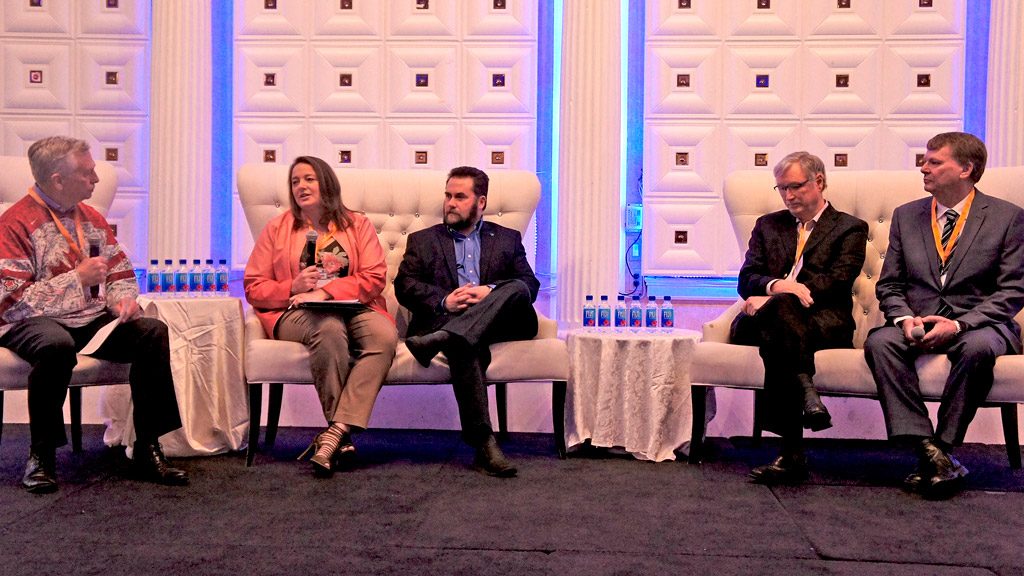Building a strong safety culture in an organization requires leadership, strong relationships, communication and the courage to stand up when you see something unsafe.
That was the message of a leadership panel billed Leading to Perform — Effective Strategies in Workplace Safety Management, moderated by Rob Ellis of MySafeWork. The panel was part of the COR Open House and Leadership Conference held March 2 in Mississauga, Ont. hosted by the Ontario General Contractors Association (OGCA) and the Infrastructure Health and Safety Association.
“Safety is not for wimps — we need the courage to say it, stand up for yourself, for your coworkers, we need to expect that from our folks,” said George Bell, vice-president, safety and security at Metrolinx. “What we need to do is make it safe for people to report failure. People will make errors, that’s what defines us as people, but we need to have that information so we can improve.”
Craig Lesurf of Walsh Canada and chair of the OGCA’s safety committee said he welcomes both negative and positive feedback from employees, adding “you can’t fix something if you don’t know it’s broken.”
“I’m never going to give you crap for telling me about something, I’m going to give you crap if you don’t tell me about something and I find out or I see something happen or a repeat mistake,” said Lesurf.
“It starts with leadership. You’ve got to set the stage, you’ve got to empower your staff, you’ve got to show that safety is important and that it matters to you and educate them as to why it should matter to them. Once you bring that into your organization, from the top down, it should come back in a rebound motion from the bottom up.”
Erin Oliver, vice-president, employee health and safety, Modern Niagara, said communication between all levels in a company is key.
“They have to have the courage to stand up and say what needs to be said which means they build a relationship where they can communicate both within their own teams and with the general contractor and their subs,” said Oliver.
“I see very regularly, when the communication starts to fall apart or people start to create boundaries or borders, that safety is the first thing that starts to show evidence of that communication breakdown. Just like a marriage, it’s not always perfect but it’s important to stay true to it. Then safety becomes the environment by nature.”
I want the worker to tell me how much of an idiot I am,
— Benjamin Amick
Institute for Work and Health
Benjamin Amick, a senior scientist for the Institute for Work and Health, says the first thing he does when he goes on site is ask a supervisor to walk him around.
“If I’m told they’re not available, that’s my first clue,” explained Amick, adding when he goes on site he often does things he is not supposed to do.
“I want the worker to tell me how much of an idiot I am and the manager or the site supervisor how much of an idiot they are for letting me do what I did. If those things happen then I’m on a site that I know has a strong safety culture to begin with…The beauty of culture is it takes a lot of time to build, but it’s very hard to break once you build it.”
Panellists also discussed the role of the media in the industry and how it affects perception.
“Unfortunately, we as individuals want to look at the negative, we always want to talk about stuff,” said Lesurf. “It’s about educating people because they think construction is unsafe because all they hear about is the bad stuff.”
Oliver said it can be leveraged as a platform for good.
“I challenge you all to go talk to your high school students, your grade schools as an advocacy because they read all this and equate it to very negative things,” Oliver explained. “We should use it as a platform for evidence-based performance going forward.”
So how do you know you have a strong safety culture in your company?
“Engagement and empowerment,” replied Lesurf.
“If you know your staff and right from the get go they know they can speak up, they can talk about unsafe acts, they can prevent stuff and it’s about reward programs and they are congratulated for doing something right. When it’s happening at the grassroots level everyday, that’s when you know you have it.”



Do to the minimum protections from the employment standards act for a new hire? Only applies after 3 months, allows a employee to be let go as the employer chooses! Does this panel have any experience in construction? Their concepts are so far from the realities of the construction workplace. Now they want to manipulate the youth by candy-coating with unsupported information. What is suggested here is preposterous! Here is a novel idea that will help this council see more clearly, get a job in construction work, start at the bottom or work along side, you will see how it has failed workers. The Ministry of Labour has its own agenda and is a threat to any jobsite’s performance. The COR concept is flawed and circumvented to get the designation, even companies who have had employees killed on the job can get COR certified! Too many chiefs trying to justify flawed ideas.
I believe that it is time to factor more time in the wellbeing/mental wellness of the staff on small to large projects. They are also an important group so also feel all the pressures of completing a project.